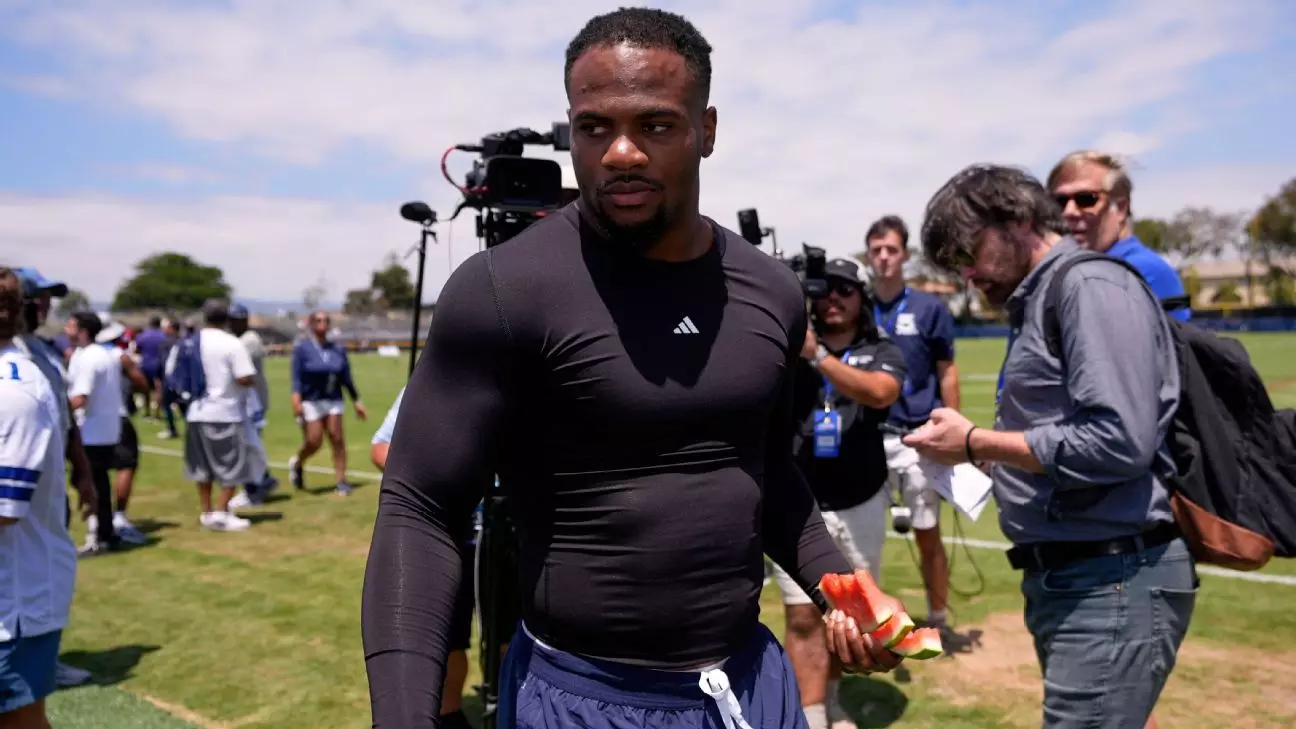In the realm of professional football, few situations generate as much buzz as contract negotiations with high-caliber players. The Dallas Cowboys find themselves in such a predicament with star edge rusher Micah Parsons. Despite the buzz around potential negotiations, there appears to be a noticeable standoff, leaving plenty of room for speculation. Coach Brian Schottenheimer’s optimistic tone about Parsons’s availability for the season opener underscores a confident belief in his pivotal player, yet it also highlights the underlying tension: the contract extension remains elusive. It is remarkable how, amid this uncertainty, the Cowboys’ coaching staff continues to prepare with an unwavering belief in Parsons’ readiness, focusing not only on his physical condition but also on his mental preparedness.
Schottenheimer’s comments reveal a strategic optimism rooted more in faith than certainty. While Parsons has not participated in full practice drills—dealing with back tightness and limited to walkthroughs—the coaching staff remains optimistic about his presence on game day. The situation illustrates a critical reality of modern NFL management: a star player’s absence from practice doesn’t necessarily diminish their impact on game day. However, this approach hinges on Parsons’s self-awareness, discipline, and recovery readiness, aspects which he appears to manage effectively by adhering to treatment and maintaining his physical wellness.
The Physical and Mental Demands on a Star Player
Parsons’s situation illuminates the delicate balance between physical preparedness and injury risk, especially in a sport as brutal as football. Coaches acknowledge that on-field readiness isn’t merely about participating in drills; it’s about executing change-of-direction movements, tackling, and sudden accelerations—all requiring a high level of physical conditioning. Parsons’s back tightness, while seemingly minor, underscores the vulnerability of soft tissue injuries to star athletes. The coaching staff’s reliance on their strength and medical personnel indicates a sophisticated understanding of injury prevention, but ultimately, the player’s own judgment and body awareness play a central role in his return to full competition.
What makes Parsons’s case particularly compelling is his self-awareness and dedication. He has consistently demonstrated a commitment to his craft, evidenced by his participation in walkthroughs and team meetings, despite missing practice sessions. Such engagement preserves his understanding of defensive schemes and calls, maintaining a mental sharpness that can compensate temporarily for the lack of physical reps. Yet, this strategy is not foolproof; without on-field practice, the risk of injury or missed timing could escalate, especially as the season progresses. The coaches’ emphasis on Parsons’s self-care and body knowledge is a testament to the evolving philosophies of player management, recognizing the science of recovery and individual responsibility.
Strategic Implications for the Cowboys
The uncertainty surrounding Parsons’s readiness has ripple effects across the Cowboys’ roster decisions, especially as they trim their squad to meet roster limits. Schottenheimer’s confidence that Parsons will be available for the Eagles game offers some reassurance, but it also pressures the team to plan for contingencies. Depth at pass-rusher becomes more critical if Parsons isn’t fully game-ready or if the risk of re-injury increases. This situation could lead the coaching staff to keep an extra pass rusher or adjust game plans accordingly, emphasizing the importance of strategic flexibility.
Moreover, the broader context of the contract negotiations adds an intriguing layer to the narrative. While owner Jerry Jones claims that an agreement was near in March, the lack of recent discussions suggests a delicate stalemate. Such negotiations can subtly impact a player’s performance and focus, yet Parsons seems determined to maximize his impact regardless of contract talks, which speaks volumes about his professionalism and commitment.
Parsons’s case exemplifies the modern NFL’s intricate dance: the desire to secure long-term financial stability against the urgent need for immediate performance. His absence from practice might be temporary, but it also spotlights a larger question about how teams manage star players facing contract uncertainty. For the Cowboys, the challenge lies in balancing their strategic roster needs while securing the deal that keeps Parsons motivated and focused on the field.
The Power of Confidence in Unpredictable Circumstances
Ultimately, Schottenheimer’s unwavering confidence in Parsons’s participation underscores a core belief in the player’s resilience and professionalism. The coaching staff’s reliance on Parsons’s self-awareness and physical discipline highlights the importance of trust—trust that a star’s mental toughness will compensate, at least temporarily, for the gaps created by limited practice. This trust is essential not only for Parsons’s individual success but also for the team’s collective morale and defensive integrity.
The unfolding weeks will reveal whether Parsons’s physical condition aligns with the coaching staff’s optimism. However, independent of how the situation evolves, one thing remains clear: Parsons’s talent, attitude, and self-awareness make him an irreplaceable asset, and the Cowboys’s confidence in his ability to contribute this season is more than mere optimism—it’s a strategic necessity. Their capacity to adapt to uncertainties around Parsons could very well determine their defensive dominance in the upcoming season.


Leave a Reply